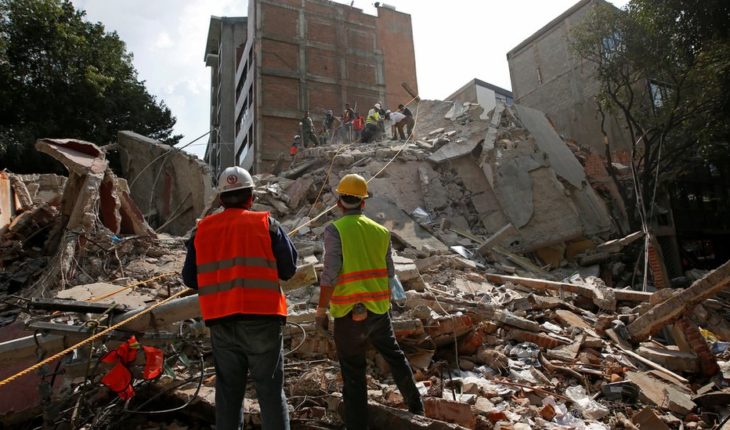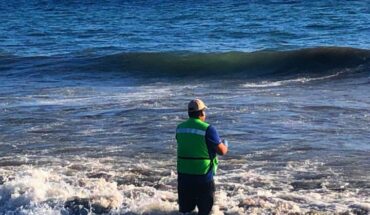In 2017, while hundreds of people had lost their wealth, relatives were recovering in hospitals and some perished in the rubble following the September 7 and 19 seisms, international aid began to flow. Mexico received donations in US, Canadian and euros dollars totaling more than 91 million pesos, but it is not known how or what they were spent on.
Nor did the donations of the “Force Mexico” Trust end, where national aid was concentrated, because there were no control, administration or distribution mechanisms, and there was no follow-up to the fate of the money and, therefore, it was not possible to determine whether used efficiently.
Read: Possible resource diversions for sedatu, Bansefi and Conavi
This was reported by the Federation’s Superior Audit (ASF) in its assessment of reconstruction work following the earthquakes in 2017. The results, revealed in the first Report of the 2018 Public Account, also show significant delays, omissions and failures in the repair of hospitals, housing and educational facilities.
On the specific subject of donations, the review included the work done with them by the Ministry of Finance and the Ministry of Foreign Affairs, then headed by José Antonio Meade and Luis Videgaray, respectively.
The Audit noted that the lack of clarity of the fate of both national and international donations was due to a lack of transparency and coordination between the units, transparency in the registration and monitoring of donations, but did not determine responsibility to officials or instructed the Internal Supervisory Bodies or the Federation’s Superior Audit to continue investigating.
Read: 290 mdp for earthquake victims disappear in Iztapalapa
Following the disaster, the Executive estimated the cost of reconstruction at 48 billion pesos, and in the face of scenes of men and women working trying to rescue people alive in the rubble and hundreds who literally stayed in the street by the affectations or collapses in their homes, the help of individuals was monetized.
For this reason, the government established the Force Mexico Trust to supposedly “coordinate” and “join efforts” with private initiative. In fact, this financial instrument is neither entirely public nor private, since “the trustee is part of the private sector initiative, led by the Business Coordinating Council and the trustee was a public entity, National Financial ( NAFIN).
This “prevented mexican state entities and units from receiving donations, administering them and relocating them to the reconstruction and rehabilitation of public infrastructure, and left that task to the private sector. This showed the lack of an ordinary legal framework on donations to regulate donations received by the federal government,” the ASF warns in the 52-GB performance audit.
Although the federal government created Platform Force Mexico where it published information regarding the advancement of reconstruction and delivery of supports, but the update data “are not consistent between the sections of “‘Emergency Support and ‘Open Data'”, in addition, no information was published there about the Trust.
Therefore, the Audit concluded that the management of the Ministry of Finance with respect to donations”was poor, as it established no basis or guidelines for issuing calls, receipt, administration, control and distribution of donations; did not establish that it coordinated with the relevant authorities, including the Secretariat of Foreign Affairs, and the Fuerza Mexico Trust, for the receipt and distribution of donations.”
In performance audit number 74-GB to the Secretariat of Foreign Affairs, it was determined that without well that the unit reported that it did not receive financial contributions due to the instruction of the Treasury that everything would be concentrated in the Fuerza Mexico Trust and the Mexican Red Cross, it was found that through diplomatic notes, the Chancellery was aware of 22 financial contributions but did not register all in the National Register of International Cooperation.
As of 2018, donations were made in cash amounting to US$3 million,234,000; 48 thousand 494 euros; 20 million 161 thousand Mexican pesos; 600 thousand Canadian dollars and 500 thousand Philippine pesos. This to conversion to the exchange rate to September 2017 totaled 91 million 803 thousand pesos.
The unit reported only 16 supports “therefore, there was no useful and reliable record of information on this type of donation, while the reception and distribution of contributions is unknown,” the Audit said.
With regard to international aid in kind, between 2017 and 2018, donations were received from 18 governments and international agencies corresponding to 12,267.0 units, 197.8 tons and 31,467.5 kilograms of aid in kind.
Of the 18 donations, the unit reported only 14 and nothing else produced receipt delivery records for 10 donations. But the data contained in them, such as the donor, the donor or the donated amount “are not solid with the supporting documentation. It was therefore determined that no useful, reliable and timely information was available on the delivery, receipt and distribution of the supports which prevented them from being followed up.”
Only 1 in 5 damaged hospitals are repaired, and doubtful
Of the hospitals that were affected by the 2017 seams in the country, on average only 1 in 5 are supposedly rehabilitated to date, with no fully accrediting data. This is poor attention on the part of the Ministry of Health to a priority reconstruction process.
This is concluded by an evaluation by the ASF of the care process of the 132 affected health centres in six entities, which shows failures from the evaluation phase of the properties concerned to the alleged completion of the work.
The report details, for example, that the diagnostic formats of the centres concerned did not include about half of the data that the regulations mark, including that of key of the location where the affected building is located, type of health centre in added and his ability. This, according to the auditors, goes back to the unreliable diagnosis.
Read: Abandoned or in reconstruction, the situation of hospitals in CDMX one year from 19S
This means that there is also no solid and technical basis justifying the 491 million pesos quantified for the repair of the affected centres, an amount that is already more than 179 million pesos than had originally been without a reason justifying this wide difference.
In turn, auditors encountered serious problems in job planning as only rehabilitation strategies based on documented assessments were documented for 44 of the 132 properties affected, with no justification for why in the 88 remaining centres did not do this work.
The ASF also reviewed five physical and financial quarterly progress reports of these works, where, however, data were reported in a generic and incomplete manner, while it was unclear how the resources were applied in accordance with the guidelines of the Natural Disasters, which is where they come from.
“There were also inconsistencies with respect to the progress made in the federal entities of Chiapas, Oaxaca, Guerrero and Morelos, due to the record of a decrease in the percentages of progress, without the Ministry of Health explaining the causes of variations,” the auditors’ report states
Most worryingly, a 21.2% advance in rehabilitation work in affected health facilities, having been reported as ready to 28 of 132.
“And even though only that level of progress was reported, it lacked information about objectives and goals, as well as documentary evidence to verify the completion of the reported projects,” the auditors said.
For this issue, the ASF issued 13 recommendations to the Ministry of Health and promoted the opening of three internal investigative dossiers.
Omissions and cost overruns in school reconstruction
The ASF credited multiple problems in the process of repairing and rebuilding 19,194 campuses that were affected by the 2017 earthquake, from deficiencies in the opinions to prove the damage and thus the required budget, to the lack of a appropriate follow-up to the point at which it is not proven that the leftovers have been completed. All this responsibility of the PMI.
In addition, the Secretary of Public Education reported the exercise of 606 million pesos, which is almost 20% higher than what had been authorized, by 2018.
“This without the unit sending the proof of expense documentation, nor explaining the causes that caused such a situation,” the auditors noted.
The ASF results report shows that damages were assessed in 5,10 schools to which resources were allocated from the Natural Disaster Fund (Fonden) and in 10,901 campuses to which resources of the Education Reform Programme were allocated.
“However, the secretariat lacked the documentary evidence to verify the feasibility of the inclusion and execution of reconstruction and rehabilitation works, so it was unaware whether the proposed works had the technical sustenance to prove their inclusion,” the report states.
You may be interested: Where is the money from rebuilding the schools?
Even in just over 40% of the reported campuses, a correct damage assessment was not even credited.
The ASF also found deficiencies in the follow-up to the proposed works, as a number ofor all the quarterly progress reports that tended to be prepared were presented, nor were the monitoring visits that should have been carried out known.
The PMI informed the auditors that 75% of the affected campuses were visited in 2018, but there is no documentary evidence to prove the results of these visits or the conclusions they should have made.
And finally, the unit also did not provide information that would account for the alleged conclusion of the works and that they were properly carried out.
“In the VIEW of the ASF, the government management of the PMI in the reconstruction and rehabilitation of the entry-level schools affected by the 2017-world six-ups was poor,” the auditors concluded.
For these anomalies, the ASF issued 17 recommendations to the SEP and asked it to open three investigations through its Internal Control Body.
Affected housing: conflicting patterns and minimal supervision
How many homes were affected by the seisms recorded more than a year and a half ago? This is information that is not clear because the official standards are contradictory, even though they are all dependent on the Secretariat for Territorial and Urban Development (Sedatu).
The ASF reported that according to the definitive diagnoses there were 172 thousand 57 homes damaged, of which 64.9% are homes with partial damage; 34.8% with total damage; and the rest with minor damage.
However, the housing standard covered by the database of programs and actions yields only 168 thousand 256 properties, while in the document for the delivery of supports with electronic cards appear only 170 thousand 871 homes. All quantities differ.
“In relation to supervision, only 59,866 homes with total damage were contracted, representing 34.9% of the 171,494 homes affected in their diagnoses and differing from the 170,871 included in their final bases , of which he oversaw 59 thousand 380 (34.6%)” the report.
Of the homes where supervision work was carried out, Sedatu reported that in only 25 thousand,584, or less than half, 75 to 100% progress was reported in the work. In the rest of the homes the advances were less than 50% and even in some cases it is completely unknown.
These irregularities, the auditors point out, cast doubt on the correct application of almost 118 million pesos that were distributed to the beneficiaries of the dwellings concerned for repair work.
In addition, the National Housing Commission provided technical assistance to 15,373 homes in the 60,302 homes with total damage that the Sedatu reported as in total damage. The Commission also showed deficiencies in the records relating to the dwellings concerned.
What we do in Animal Político requires professional journalists, teamwork, dialogue with readers and something very important: independence. You can help us keep going. Be part of the team.
Subscribe to Animal Politician, receive benefits and support free journalism.#YoSoyAnimal
translated from Spanish: It is not known what the donations of the 2017 earthquake were spent on
June 29, 2019 |





